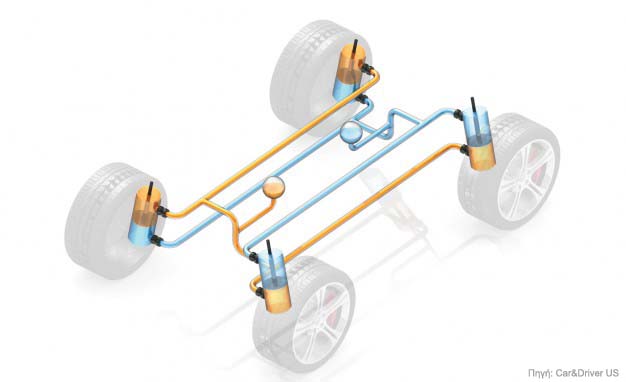ringo wrote:Dragonfly wrote:On that photo of the Mercedes what do you think is the black cylindrical object beneath the differential and connected with hoses to the pull rod rocker assembly?
It could be an accumator with a hydraulic dsiplacement differentiator.
................
I also think so, and that's why I asked this question.
Ringo, I don't have the technical background many of you have here. But I own and drive an aging Citroen "Xantia". I took it because I was curious about the suspension since I was a boy. Initially it seemed complicated, but now I know it and it is a relatively simple and reliable thing.
By Citroen terminology this is a "sphere" (IMO), which can either be a dedicated accumulator or a act as a spring and a damper 2 in 1. On a Citroen the left and right wheel are interconnected by the tubing for each axle. There is no interconnection between front and rear. On the so called "hydroactive" variation there is a third "sphere" for each axle which can be connected or disconnected from the common pipe contour by means of a valve. If all 3 are connected, the suspension is soft, if the third is disconnected, it becomes stiffer. This is achieved by different gas pressure (different spring rates) in the side ones and in the middle one. Also the damping holes and valves are different.
So I was thinking about a similar principle - connect or disconnect an accumulator to the hydraulic circuit and obtain different characteristics. And I presume it can be achieved in a passive manner by just using valves and switching routes for the hydraulic liquid. For adjusting spring rates they can simply use different pressures, and by changing a simple block with calibrated holes and leaf valves on it - change the damping characteristics.
As a side note: self leveling on a classic Citroen is a pure mechanic solution - 3 way valves connected to the anti roll bars (front and rear) and activated by their twisting under a changing load. With more load hydraulic liquid is fed from a high pressure accumulator to the hydro cylinders, acting as struts until the roll bar moves back to normal position. On less load, liquid is bled from there.
The only thing I see as not compatible with F1 rules is that the system has a pump which keeps the main accumulator full and under the desired pressure, as the bled liquid i returned to the tank.
P.S.
If someone is interested there are many sources on the net. like this one
http://www.citroenet.org.uk/miscellaneo ... ics-1.html
